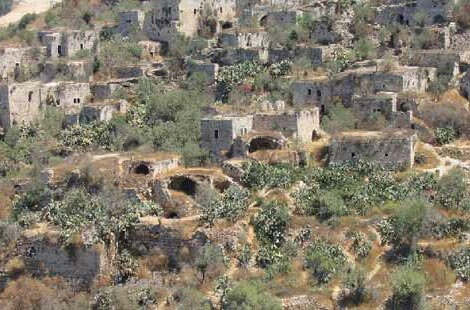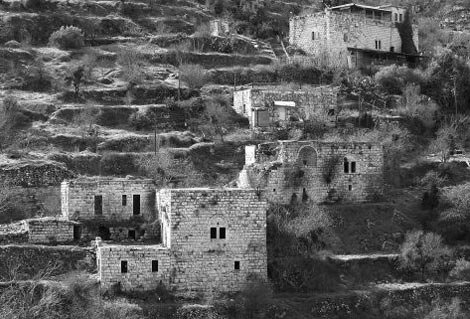The ghost town between Palestine’s past and its future
 Tuesday, May 3, 2011 at 09:37PM
Tuesday, May 3, 2011 at 09:37PM 
Lifta, Jerusalem: Last visible remnant of the Nakba
By Catrina Stewart, The Independent
/www.independent.co.uk/news/world/middle-east/the-ghost-town-between-palestines-past-and-its-future-2276864.html
Catrina Stewart visits an abandoned settlement, frozen in time 63 years ago, that may soon become a luxury housing development
Walking through the abandoned Palestinian village of Lifta, Yacoub Odeh is transported back to a time more than 63 years ago when as a child he would play in these streets before his carefree existence came to an abrupt end.
As he points out the old mosque and olive press, names come tumbling back, events, memories – a life before 1948, the fateful year that hundreds of thousands of Palestinians fled their ancestral homes during Israel’s war of independence, most of them never to return.
All that remains of this once-prosperous village are the shells of dozens of houses dotted throughout the valley, their outer walls largely intact but now overgrown with wildflowers and weeds.
How much longer the village will remain in this state is anyone’s guess. It is at the centre of a wrangle over whether it should be preserved in its current state as a reminder of the Palestinian dispossession or redeveloped into luxury housing. The Israel Land Administration, now the legal owner of the land, is marketing plots to developers to construct an upscale neighbourhood based on the buildings that already exist.
“They [the Jews] did not destroy Lifta in time of war, so they should not destroy it when Israel is talking about peace,” says Mr Odeh, a Palestinian in his early 70s who spent his early childhood there.
Lifta is the last of the deserted Palestinian villages still standing in modern-day Israel. The several hundred other communities abandoned have either been built over, destroyed or resettled. Proponents of redevelopment say it is not as simple as letting Lifta remain as it is. Architects involved with the new housing project in its early stages say to do nothing at all would ensure the eventual disappearance of the village.
But Shmuel Groag, one of the same architects who wanted to restore the village, is aghast at the scale of the new project, targeted at wealthy buyers. Developers have drawn up a plan that adds another 268 apartments and a hotel to the 55 houses currently there.

Lifta (Photo: Aisha Mershani)
[More Lifta images on Aisha Mershani's website]
The developer handling the project declined to be interviewed for this story, but the Jerusalem municipality which first approved it in 2006 insisted the village’s character would not be changed, and the existing houses and buildings would be carefully restored and preserved.
Petitioners, including former residents of Lifta and Israeli NGOs, have secured a temporary injunction to freeze the project on technical grounds. It is an imperfect solution as, even if the developers are forced to return to the drawing board, they could return with an amended plan. What the petition fails to address is the issue of two competing historical narratives that has underscored the tensions between Palestinians and Israelis for generations.
“On setting up its state in 1948, Israel set about demolishing every vestige of Palestinian life and history in the land,” writes Ghada Karmi, a Palestinian author, in a recent letter to the Los Angeles Times. “The battle to preserve Lifta must be won – it remains a physical memory of injustice and survival.”
In 1947, a United Nations partition plan proposed to divide Palestine into a Jewish and Arab state with Jerusalem as an international city. The Arabs opposed the plan, and fighting erupted between the two sides as they scrambled for territory before the British Mandate expired.
The Palestinians claim that they were driven out by the Jews or frightened into flight by acts of brutality in other villages, while Israel contends that they left of their own accord during a time of war, foregoing the right to their land under Israel’s absentee laws.
Mr Odeh was just eight years old when the shooting started one day in January 1948. Tensions were already high – a month previously, the Stern Gang, the pre-state Jewish militia, had killed six of the villagers in the coffee house in an apparent reprisal attack. Occupying a strategic position at the entrance to Jerusalem, Lifta became an important target for Jewish fighters. When the first shots were fired in the village, Mr Odeh’s father hoisted his youngest child on to his shoulders, and bade his wife and children to follow as they made for a nearby road. With several other families, they boarded a truck heading away from Jerusalem.
“We went only in the clothes that we wore because we [thought we] were coming home the next day,” says Mr Odeh. “Everything – clothes, food – remained at home.”
Like most Palestinians who fled, he could not return home. Jewish soldiers blew up the roofs of their homes to make them uninhabitable, and chased off those who did try to come back. By the end of February, the village’s nearly 3,000 inhabitants had all left.
The family initially lived in Ramallah, where Mr Odeh says he slept under a tree and queued long hours for food. His father succumbed to illness and depression and died soon after. The family later settled in Jerusalem, and, when he was old enough, Mr Odeh joined the Palestinian resistance, a step that would earn him 17 years in an Israeli jail and see his family home destroyed once again, this time in retribution.
The Palestinians describe the events that led to the creation of Israel as the Nakba, literally “catastrophe” in Arabic. By UN estimates, more than 750,000 Palestinians fled during fighting in 1947-1948, some to the West Bank, others further afield to Jordan, Syria and Lebanon, where most ended up in refugee camps that still exist today.
Many dream of one day returning to their villages, and still hold the deeds to their abandoned homes. But, for now, there is little meaningful discussion at government level in Israel regarding the mass return of Palestinian refugees, which many Israelis believe would spell doom for Israel.
“Many places in Israel were abandoned,” says an official from the Israel Land Administration, pointing out that Jerusalemites are leaving the city in droves due to a shortage of housing. “If we waited for all the refugees to come back, we wouldn’t have a country.”
Some argue that Israel could nevertheless seize an historic opportunity by allowing a symbolic number of refugees to return to Lifta, a move that would create goodwill at little cost.
“If we do destroy it, this would send a very bad message on many levels to the Palestinians,” says Eitan Bronstein of Zochrot, an Israeli organisation that has meticulously recorded all the pre-1948 villages. “It sends a message that we don’t care and will continue with this plan to [keep] this country only for Jews.”
It was David Ben-Gurion, Israel’s first prime minister, who said “the old will die, and the young will forget” in an assurance that the Palestinians would never come back. Mr Odeh, who these days takes guided tours around Lifta, is determined to ensure that will never happen, bringing his children to this spot at least once a year, urging them to remember.
“We lost everything when we were kicked off our land,” he says, adding that he simply wants Israel to acknowledge what he and others went through. “We have the right to live free in our home.”
 APJP |
APJP |  Post a Comment |
Post a Comment |
Reader Comments